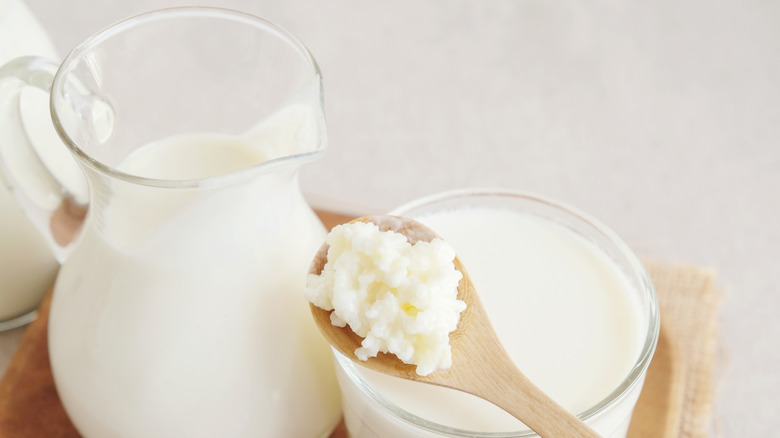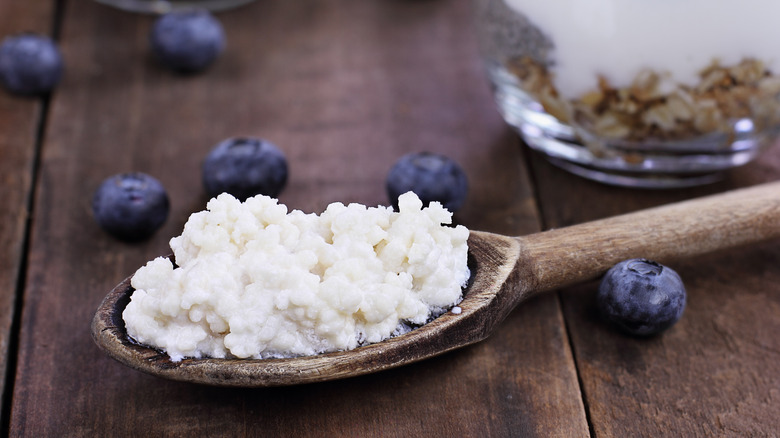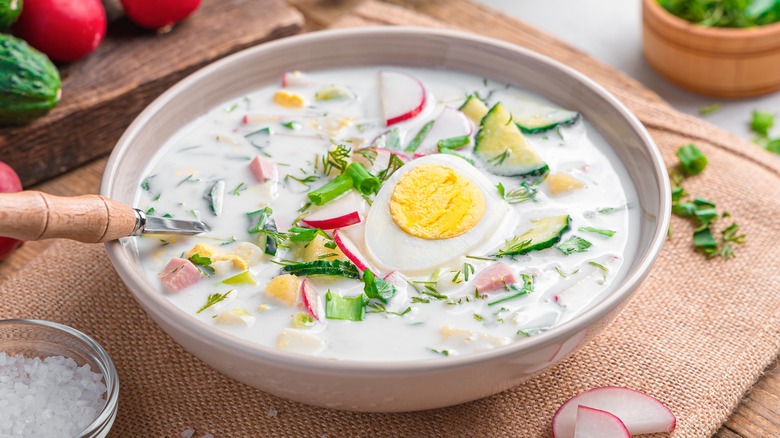For A Tangy Sour Cream Substitute, Try Kefir
The secret to the fluffiest waffles is a little sour cream, but if you're looking for a tangy substitute, you can just as well use kefir. Not only will it taste similar, but the swap has a ton of health benefits. For example, kefir has significantly less fat and cholesterol than sour cream, which makes it ideal for those watching their heart health. This dairy drink may also improve lactose digestion, balance gut flora, and protect against cancer, according to 2023 evidence published in the journal Fermentation. Its antibacterial, antiviral, and anti-inflammatory effects shouldn't be overlooked either.
As the researchers note, kefir is rich in probiotics and enzymes that help your body break down lactose. Therefore, it's often better tolerated than milk and other dairy foods. Both kefir and sour cream are fermented with lactic acid bacteria, but the latter undergoes more extensive processing. For this reason, it has a lower probiotic count.
Need one more reason to swap sour cream for kefir? This fermented drink has roughly 60 calories per 3.5 ounces, while the same amount of sour cream boasts approximately 200 calories. Kefir is tangier and less creamy, but you can still use it in smoothies, sauces, parfaits, or ice cream for a velvety texture and extra flavor. Whether you're watching your health or ran out of sour cream in the fridge, this is a great switch to make.
What exactly is kefir?
Commonly referred to as "the champagne of the dairy world," kefir is a milk drink similar to yogurt. Its slightly acidic flavor and thin consistency make it ideal for salad dressings, oatmeal, pancake batter, sourdough bread, and marinades. The word "kefir" is derived from "keyif," which can be translated as "feeling good after eating." Its origins can be traced back to the late 19th century when Balkars and other populations in the Caucasian mountains started to ferment milk in leather bags and produce kefir grains.
These live cultures consist of lactic acid bacteria and yeasts, such as Lactobacillus kefiri, Lactococcus lactis, Candida kefyr, and Streptococcus thermophilus. Their exact composition depends on the type of milk used, among other factors. For example, Turkish kefir has a different microbial composition than Tibetan or Irish kefir. These microorganisms inhibit the growth of pathogenic bacteria and break down lactose into sugars.
The beverage is produced by inoculating milk with kefir grains. This mixture undergoes fermentation for 12 to 24 hours and can be refrigerated for up to one week if unopened. If it is opened, you have one to two days to consume it. Its flavor may vary depending on the grain-to-milk ratio, fermentation time, storage conditions, type of milk, and other factors. The final product is a probiotic-rich drink that can replace milk, sour cream, and yogurt in most recipes.
How to use kefir as a sour cream substitute
Plain kefir has a tangy, slightly sour flavor that resembles that of aioli or yogurt drinks. You can enjoy it as is or use it as a sour cream substitute in pancake toppings, baked goods, fruit parfaits, gravies, and more. For example, some people add kefir to creamy soups just before serving or drizzle it over baked potatoes for a refreshing tang. Another option is to mix it with lemon juice, herbs, and olive oil to make a light salad dressing.
If you're on a diet, use kefir as a sour cream alternative in dips, mashed potatoes, crepes, or rice dishes. With its tangy flavor, kefir can also be a wonderful addition to savory crepes, casserole toppings, or deviled eggs. Apart from that, you can use it in most baked goods, from cookies and pound cakes to sweet bread.
As a final word, you may still want to use sour cream as a topping for sliders, enchiladas, or quesadillas since kefir is runny and won't match the consistency you're looking for. However, you can mix kefir with cream cheese, mayo, or other thick ingredients to get it to the thickness you want — it will just have a slightly different taste from sour cream at that point.


